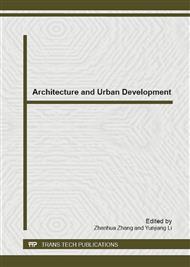p.152
p.156
p.164
p.171
p.176
p.180
p.184
p.189
p.193
Comprehensive Evaluation Method for Ecotype and Safety Performance of Building
Abstract:
The ecotype and safety performance of urban buildings is affected by many factors. The evaluation method of unascertained measure model has been adopted, through analyzing the traits of the evaluating method and building performance indexes. Based on analyzing and researching, a relatively integrated evaluation indexes system has been established in this paper. The advantages and disadvantages of all factors have been shown out through analysis. Through factual application, the viability and maneuverability of this method has been confirmed. At the same time, the analysis results will provide scientific decision-making for improving the ecotype and safety performance of urban buildings.
Info:
Periodical:
Pages:
176-179
Citation:
Online since:
November 2012
Authors:
Price:
Сopyright:
© 2012 Trans Tech Publications Ltd. All Rights Reserved
Share:
Citation:


